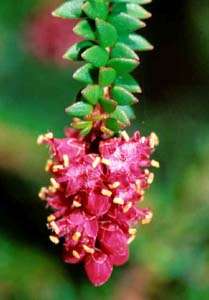Trochocarpa thymifolia
Trochocarpa thymifolia is a common montane and subalpine shrub from the plant family Ericaceae (originally Epacridaceae).[1] Originally described by botanist Robert Brown in 1810,[2] it is a widespread Tasmanian endemic that inhabits mountain regions.[3] It is named after its characteristic thyme-like leaves, and due to its delicate pendulus flower-spikes is known colloquially as 'Delicate Trochocarpa'.
| Trochocarpa thymifolia | |
|---|---|
 | |
| Trochocarpa thymifolia with drooping terminal spike | |
| Scientific classification | |
| Kingdom: | Plantae |
| Clade: | Tracheophytes |
| Clade: | Angiosperms |
| Clade: | Eudicots |
| Clade: | Asterids |
| Order: | Ericales |
| Family: | Ericaceae |
| Genus: | Trochocarpa |
| Species: | T. thymifolia |
| Binomial name | |
| Trochocarpa thymifolia | |
| Synonyms | |
| |
The species is synonymous with: Decaspora thymifolia and Decaspora oxycoccoides, and commonly confused with Trochocarpa parvifolia (current taxon: Acrotriche parviflora[4]).
Description
Mature plants form erect, bushy shrubs, with small, densely-packed, ovate to elliptic leaves (2–4 mm long). Leaves are dark green, slightly lighter green on the underside, with parallel venation - a distinguishing characteristic of the family Ericaceae. Flowers possess 5 lobes, range from pink to red, and are 4mm in length. Inflorescences form dense, drooping terminal spikes 1.5 cm long. Fruits are spherical, fleshy, blue to purple in colour, and approximately 8 mm in diameter. Fruits and flowers are usually present simultaneously, creating stunning displays of contrasting colours and textures.[1][5]
References
- Gibbs, L.S. (1920). "Notes on the Phytogeography and Flora of the Mountain Summit Plateaux of Tasmania". Journal of Ecology. British Ecology Society. 8 (2): 89–117. doi:10.2307/2255528. JSTOR 2255528.
- Brown, Robert (1810). Prodromus Florae Novae Hollandiae et Insulae Van Diemen. London: Richard Taylor & Son.
- Kirkpatrick, J. B. (1982-01-01). "Phytogeographical Analysis of Tasmanian Alpine Floras" (PDF). Journal of Biogeography. 9 (3): 255–271. doi:10.2307/2844668. JSTOR 2844668.
- "Trochocarpa parviflora, Bentham, G. (1868), Flora Australiensis 4". biodiversity.org.au. Retrieved 2016-03-19.
- "Key to Tasmanian Dicots". www.utas.edu.au. Retrieved 2016-03-23.
External links
| Wikispecies has information related to Trochocarpa thymifolia |